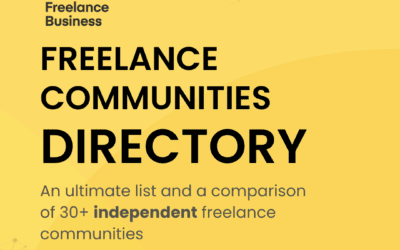When you ask freelancers how they price their services, chances are they will describe one of the following pricing methods:
- Hourly rates—“I will invoice you €40 every hour worked on this project at the end of the month”.
- Day rates—“You can book my expertise for €600 a day.”
- Monthly rates—“I will commit to your project for a monthly fee of €5500.” (SIKE! You just got employed! Without any benefits, by the way.)
- Flat fees (package price)—“I’ll set up a Wix website for your business for a flat rate of $1500.”
- Retainers—“I will be on standby whenever you need me for advice on your investments. Access to me starts at €500 a month.”
- Value based pricing—“How much revenue would a brilliant Wix website generate for you with perfectly tuned conversions and whatnot? €150.000 per year? Great, I’ll build exactly that site for you for €15.000.”
All of these are valid pricing models. There is no right or wrong approach, since many of them can work for specific business cases. No wonder people struggle to find their fit!
So, what now, where do we start? And wait, you can get 15k for a Wix site, is this even real life?
Yup!
Let me show you how.
Comparing different pricing models
Let’s see how these different pricing models compare. They might work for a freelancer short-term, but will not be a good fit long-term.

On one end we have hourly rates and package deals. Most clients are already familiar with these concepts, and they accept a number that you throw at them (ease of pitching the concept).
On the other end, your day rates, project fees, and value based pricings. These generally tend to work better for more experienced freelancers, handling bigger projects.
Let’s expand on the value-experience connection.
Professional experience has an effect on your pricing structure
Most freelancers starting out tend to gravitate towards the hourly and package deals when they start out.
Then, as they gain more experience in their craft, as well as confidence in pricing, they transition into more value-based pricing or retainers when more experience is gained.
Something like this:

Notice that you can indeed earn good money with hourly rates, but there is definitely an upper limit to what people are willing to pay before it just becomes ridiculous.
Now, what happens if you are an able and experienced creative professional?
If you become a freelancer with years of professional experience under your belt, as well as an impressive portfolio, you can “skip” the line and start with flat fees, retainers, and value based pricing.
Also, if you have experience in standing up for your worth (previous instances of contract negotiations for example?) you can implement value based pricing much “sooner”, even with much less professional experience.

Some value based pricing experts would even argue that there is no lower entry limit to pricing—and to a certain extent, I agree to that. But in practice, this is how it usually goes.
On one end, hourly and package rates are easy to figure out.
You just factor in the following:
- Your time’s worth. Answer this: how much would you like to earn in a given month? You divide this number by 160 work hours. You can multiply that by 1.5 to account for sick days and uncertainties (Say you want to earn 5k a month. This means with €5000 / 160 x 1.5, your hourly rate is €46)
- Project duration. How many hours of your work would it take to finish the project? Maybe 20 hours? Great, let’s multiply that by 1.5 to again account for admin work, uncertainties, revisions. So if the client isl booking for a project price, you can quote EUR 1400 (20 x €46 x 1.5, and then we round it up a little).
But what about the other end?
This is where things get interesting. Because value based pricing does not really care about your time or project length. It cares about risks involved, and value generated.
It’s time to make a formal introduction to value based pricing.
Value-based pricing relies on the client’s perceived value of your service.
What if we were to price the same service differently based on the client?
Designing a logo for Nike and designing a logo for a pizza joint is, at the end of the day, the same.
It’s just a logo. Right?
And yet, I bet a new Nike logo wouldn’t go for €150.
Meet value based pricing.
The core principle of value based pricing is that the more value your work generates (revenue generated, time saved, risk avoided), the more the client will want to bring you in.
To understand this better, it’s time to put our “client” hat on, and think with their brains. Let’s look at pricing from their perspective.
Let’s take a look at a detailed example:
You remember that 15k Wix Website?
If I can develop a website that brings in €150.000 every year, how much is that worth to a client? Probably a lot.
Let’s play this out, how would a proposal for such a project look like?
So… you have your initial call, you do the maths, and send a proposal with a quote 15K.
Now… say the client is not happy with your offer, and says “my cousin has done WIX websites, and he can do the website for far less. Why should I pay 15k?”
What happens if the client’s cousin does that website for the client? He may be great, or not. But is the client really ready to risk his whole YEARLY revenue of 150k on that?
Because for the client, the equation here is really about three things.
- Revenue generated (1)
- Time saved (2)
- Risk avoided (3)
Because if the cousin does that website (not well), conversion rates drop, traffic drops, and suddenly, his business is not doing 150k a year. It’s projected to be closer to 80k. So the client might start losing money (1), a lot of money. Then, they will have to contract somebody AGAIN to do the website properly, thus wasting months and months of time (2). All of this is a huge risk for the client (3).
If I do the website, the client will be happy on all three fronts.
By choosing my services, yes, he will have to pay 15k, but he’s good on all three pain points:
- They will earn a lot more money because it will be a kickass website (1)
- My previous works prove that I can deliver the service in a timely manner (2)
- And the extra they are paying me is to avoid the risk of losing money and time (3)
It all makes sense right?
So let’s break down what we did here.
Value based pricing is the dark art of making the client see and understand the value and risks present in a potential deal. In fact, if you do this properly, the client will actually want to pay you more. Crazy, right?
I know, but what’s crazier is that it actually works.
Another great thing about value based pricing is that you are incentivized to work fast & work well. After all, you are not looking at your clock, your goal is not to rack up consulting hours, you are in the same boat as the client: wanting to get the job done as best as possible, as soon as possible.
So when should you pick this form of pricing?
To sum up, generally speaking though, value based pricing is:
- a great fit for experienced freelancers who generate a lot of value with their work,
- the more tangible and measurable your end results are, the easier it will be to sell,
- and the bigger the client and the project, the greater the risk involved,
- and if the risk is great, the client will pay a lot for you to get it right.
Pricing is finding out the value provided and the risks involved
So let’s recap.
Your level of experience, the risk involved, client size and project size are all interconnected in pricing. This is especially true in value based pricing.
However, we already hinted at the possibility that all of our freelance pricing models can make sense in certain business cases.
The general rule of thumb is that, the bigger the project, the bigger the client, and the risk involved, the more you skew from hourly pricing to value-based pricing.
Alternatively, if you are not comfortable yet with value based pricing, anything in-between is fair game for day rates and weekly rates.
The Author of the article is Peter Balog, Inbound Marketing Consultant and Founder of Freelance.Pizza.




